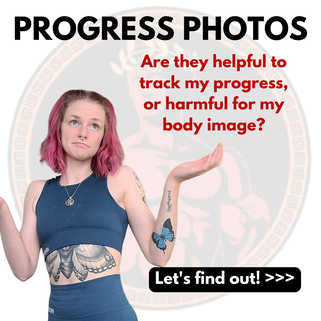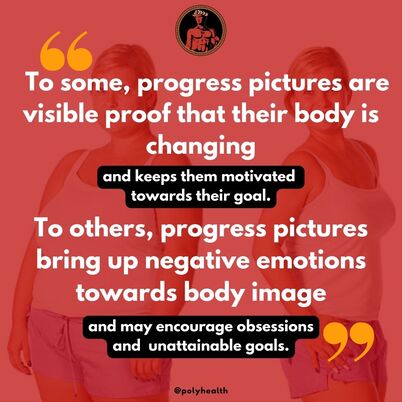|
WRITTEN BY RIEGANN MCAULEY It’s common for people to want to use exercise and nutrition to make changes to their body. The concept of progress pictures is simple: regularly take pictures of yourself to assess body changes, typically while working towards a fat loss or aesthetic goal. To some, progress pictures are visible proof that their body is changing to keep them motivated towards their goal. To others, progress pictures bring up negative emotions towards body image and encourage obsessions with unattainable aesthetic goals. Here we will delve into the history of why and how we use aesthetics to assess ourselves, why some people benefit from assessing their journey with progress pictures, why others find it damaging, and best practices to ensure you are using progress photos in the healthiest way possible if you choose to. Here’s how the art of assessing and sculpting your body started…During the mid-to-19th century, German immigrants introduced fitness and exercise systems based on gymnastics to America. As the influence of these systems spread, people became worried that the sedentary lifestyles of white-collar workers were causing them to become ill. More systems including folk games, dances, sports, military training, and calisthenics were developed in response. Some forms of fitness training became practiced in schools as the concept of fitness became recognized as a preventative measure to illness. As western culture evolved through time, the purpose of fitness changed, and exercise was promoted differently to men and women. In the 1950s, exercise was used to cope with weakness after the war. In the 1960s, the purpose of exercise was to resist fatness caused by the increased use of motor vehicles and televisions. Fitness for women revolved around becoming thinner, while fitness for men promoted overall physical health. With the emergence of bodybuilding systems based on lifting weights at the gym in the mid to late 20th century, it became increasingly popular for men to exercise for aesthetics. In the late 1980s, the fitness industry became recognized by more markets, and the consumer culture of fitness was formed. At this time, before and after comparison pictures were mainly used to advertise sports supplements and fitness challenges. How are progress pictures used now?Using progress pictures to assess and celebrate body changes has become habitual in our current daily lives and is no longer only used for marketing purposes. You can probably think of friends and family members that you know who display their transformation photos on social media, documenting their health and fitness journey. Progress pictures have become so popular because they provide visual evidence that transformation is possible. They are used heavily by social media users in their health and fitness journey to encourage, support, and celebrate themselves and others to keep going even when things get discouraging. Pursuing a healthier lifestyle that involves body changes takes a lot of work and progress pictures are a true impression of one’s commitment to their goals that can often go unnoticed when, for example, the number on the scale isn’t moving as fast as one would hope. Progress pictures are a great additional piece of data to other measures such as scale weight, qualitative evaluation, and blood work to track changes that occur during a fitness journey that are not limited to body fat loss or muscle gain. For example, progress pictures can show changes in posture which can serve as a reflection of back, hip, and joint strength gained. Progress pictures can be used to assess changes in skin, hair, eyes, and nails to show changes from increasing micronutrient intake. Progress pictures can even show changes in one’s confidence as they tend to appear happier and hold their head higher in their pictures as they progress through their fitness journey. Many health and fitness professionals agree that progress pictures, when used properly, are beneficial to track success. However, they have some drawbacks. As the fitness craze has continued to rise since the beginning of the 20th century, so has the idea that fit and healthy people are superior to the unfit. The issue with this is that there is no clear definition of what a fit and healthy person looks like. Studies show that all bodies, no matter the shape or size, can demonstrate a healthy lifestyle. Despite this, our society has been conditioned to associate only lean, young, white, chiseled physiques with fitness and health. As much as progress pictures can be used for good, they can also feed into this cultural preoccupation with thinness and muscularity. Some progress pictures tend to imply that being thinner is always better than being fatter, that a smaller body always deserves more recognition than a larger one, and that if you can’t obtain and attain the after image, your personal health and fitness journey is a waste. This can be discouraging for people who want to get fit and healthy but will never look the same as the image of health and fitness portrayed by society and can be triggering for people who struggle with disordered eating, trauma, and body image issues. It is also easier now more than ever to outright fake an after picture with the use of different poses, lighting, filtering, and even photoshop. This pushes those who see such pictures even closer to look down on their own body and set unrealistic aesthetic expectations for themselves rather than focusing on attainable lifestyle changes that will allow them to achieve the most important goal of any fitness journey - getting healthier.
So, are progress pictures helpful or not?The reality is that sharing progress pictures isn’t inherently bad. The problem is that our society almost always puts one single body type on a pedestal and associates it with health. Using progress pictures can be negative if you view them and yourself negatively but they can also be positive if you use them in the right way. It is important to understand this if you want to use pictures to track your progress healthily and effectively. If you are going to take progress pictures, make sure that you set realistic goals for your body type and lifestyle. Take pictures frequently to document your entire health and fitness journey rather than taking one before and one after photo hoping for a huge transformation to occur between the two. Refrain from comparing your body to someone else’s and avoid following people that make you feel bad about the way your body looks. Be aware that your health and fitness journey is valid even if it doesn’t involve losing weight or gaining muscle and congratulate yourself on the strength, knowledge, and confidence gained in the process. Recognize any uncomfortable feelings that may come up when taking and looking at pictures of yourself. If taking pictures makes you view yourself negatively or become triggered, know that you can stop taking them at any time. There are many ways to visually assess progress besides the traditional front, side, and back view pictures. Take pictures of a meal you made that you are proud of, an outfit you felt confident in, or a video hitting a strength or endurance goal in the gym. Finally, the most efficient way to keep a positive mindset and properly track your progress with pictures is to hire a coach to guide you through your journey. The right coach will not demand that you need to take progress pictures. The right coach will explain all possible options to track progress and allow you to determine whether progress pictures will be a useful tool for your goals. The right coach will not cast judgments when assessing your pictures or make you feel bad about the way you look. The right coach will keep the ultimate focus on helping you become a healthier version of yourself and empower you to continue to grow in your journey mentally and physically to reach your goals- no matter what you look like or how you choose to track your progress  Coach Riegann is a Certified Personal Trainer and studying to become a Registered Dietitian and member of the polyhealth team. Follow her for more fitness and nutrition tips at @riegsmcfit REFERENCESBerardi, J. (2021, October 29). Before and after photos: Inspirational and effective or demoralizing and unethical? Precision Nutrition. Retrieved December 30, 2021, from https://www.precisionnutrition.com/before-and-after-photos
The Healthy Mummy. (2018, March 22). Why taking progress photos on your weight loss journey is so important! The Healthy Mummy. Retrieved December 30, 2021, from https://www.healthymummy.com/progress-photos-so-important/ How to take useful progress pictures. The Betty Rocker. (2021, April 21). Retrieved December 30, 2021, from https://thebettyrocker.com/how-to-take-progress-pictures/ MARTSCHUKAT, J. Ü. R. G. E. N. (2011). “the necessity for better bodies to perpetuate our institutions, insure a higher development of the individual, and advance the conditions of the race.” physical culture and the formation of the self in the late nineteenth and early Twentieth Century USA. Journal of Historical Sociology, 24(4), 472–493. https://doi.org/10.1111/j.1467-6443.2011.01415.x Mauldin, K., Gieng, J., Saarony, D., & Hu, C. (2021). Performing nutrition assessment remotely via Telehealth. Nutrition in Clinical Practice, 36(4), 751–768. https://doi.org/10.1002/ncp.10682 McKenzie, S. (2016). Getting physical: The rise of fitness culture in America. University Press of Kansas. Pfister, G. (2009). The role of German Turners in American Physical Education. The International Journal of the History of Sport, 26(13), 1893–1925. https://doi.org/10.1080/09523360903148671 Ramos Salas, X., Forhan, M., & Sharma, A. M. (2014). Diffusing obesity myths. Clinical Obesity, 4(3), 189–196. https://doi.org/10.1111/cob.12059 Welch, F. G. (1869). Moral, intellectual, and physical culture, or, the philosophy of true living. Wood & Holbrook.
0 Comments
Leave a Reply. |
Marc Morris PhD CSCS Dr. Marc is an online nutrition and strength coach. Marc leverages his athletic experience and credentials in biochemistry and human nutrition to provide evidence-based but practical recommendations to clients and the fitness community. Archives
February 2022
Categories |
Services |
Company |
|
|
© POLYHEALTH NUTRITION AND FITNESS INC. 2021. ALL RIGHTS RESERVED.
|
Website Design by My Personal Trainer Website
|





 RSS Feed
RSS Feed